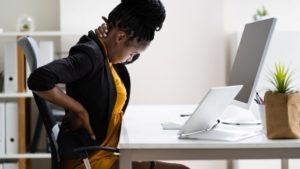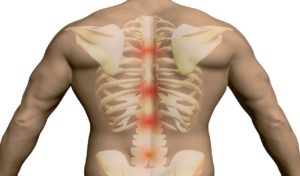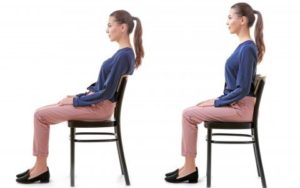Are you tired of suffering from nagging thoracic back pain caused by poor posture while sitting?
Discover how to sit with good posture and prevent thoracic back pain with these expert tips.
Sitting for Too Long?
When you sit at your desk in the morning, everything seems fine and you feel energetic and excited to start working.
However, as your day progresses, the muscle tightness around your thoracic spine gets worse.
Your back starts feeling sore and your neck starts to hurt.
Sometimes, you don’t even know how you’ll make it through to home time, because the pulling feeling between your shoulder blades becomes unbearable.
The problem is: this thoracic back pain is not the only negative effect that prolonged sitting has on your health.
With the passage of time, too much sitting will affect not only your spine health leading to thoracic spine problems, but also your:
- joints, muscles,
- tissues,
- internal organs (e.g., heart and lungs) and metabolism! [1,2,3]
But DON’T WORRY! all these terrifying health problems can be prevented if you learn why they take place, and learn the proper techniques and the best customised thoracic back pain exercises to prevent and — in many cases — even cure them.
Learn how Hayley, Jan, Dr Christian, Michaela, Elizabeth Tiffany , M Taylor and Franco successfully rehabbed their back injuries and beat their back pain.

So, How Dangerous is Sitting?
Sitting for long can sometimes be unavoidable; when you have no other option but to spend long working hours at your desk, or even if you work from home due to the COVID-19 lockdown.
A lot of us – who work desk jobs – sit down for at least 8 hours a day – that’s 40 hours a week!
We’re all aware that this is pretty bad news for our health,
But do we know just how bad it is…?
In fact, these long hours you spend on your chair – or couch – can be a major cause of:
Thoracic back pain:
Slouching places stress on your back muscles, ligaments and tissues leading to the “familiar” feeling of soreness in your thoracic, paraspinal and lower back muscles.
The pain can be really disabling. [4,5]
“When in pain, I couldn’t move properly”
– Said Franco describing his lumbar and thoracic back pain.
But you don’t need to worry.
Here is how his experience turned out:
– “ I’ve had no flare-ups since training with Jazz. I have no more dullness or low level of constant pain on my back. I can move freely without thinking about movement. When I started training with Jazz I couldn’t do more than 3 chin ups at a time. I can now complete up to 10 in one go. My record to date is 12 chin ups in one go. That’s more than a 300% increase in strength in just two months!”

Disc injury:
In addition to Thoracic spine problems, placing too much load on your disc can potentially lead to disc bulge or herniation specially when the muscles around your spine are weak due to inactivity.
This can lead to pain around your spine or even referred pain to your arms or legs. [5]
Neck pain:
Due to the faulty posture you assume while sitting, your neck muscles, ligaments and discs are all stressed, leading to neck pain, disc injuries dysfunction of your joints (e.g., jaw and shoulders) and also compression on your peripheral nerves. [6]
Pins and needles down your arms?
This is a common complaint after sitting for long.
It can be caused by your neck muscle spasm, cervical discs, spondylosis or peripheral nerve entrapment.
If you have clearance to exercise contact now Jazz Alessi, London’s best expert back pain rehabilitation specialist…
Request a FREE CONSULTATION NOW!
Nerve compression:
Muscle weakness, poor posture and too much stress on your nerve outlets may lead to compression of nerves.
It does this whether by a protruding disc in your spine, or by narrowing of nerve outlets (e.g., thoracic outlet syndrome) or by compression on the nerve itself as it courses along your limbs (e.g., ulnar or sciatic nerve) [2, 6]
Weight gain:
Did you know that inactivity is a leading cause of gaining fat and losing muscle mass?
It also slows your metabolism and puts you at more risk for serious health condition like:
- insulin resistance,
- increased triglycerides and
- increased risk for heart disease. [1,2,6]
Before you find out how to reduce your thoracic pain, solve your thoracic spine problems and learn the best and effective thoracic back pain exercises, you need to learn what causes your pain at the first place.

Meet the Thoracic Spine
Some people think of the thoracic spine as the most stable, least mobile part of the vertebral column.
Thus, they believe that it is the least prone to injury.
As a matter of fact, the thoracic spine is also at risk because of its different structure and function.
Here is why…
Being the Longest
The thoracic spine is the longest part of the spine.
It is composed of 12 vertebrae and it connects the cervical spine above with the lumbar spine below, it runs from the base of the neck down to the abdomen. [5]
Being the longest is one of the reasons why the thoracic spine is prone to:
- deformities,
- injuries and
- soft tissue restriction. [5]
The length of the thoracic spine makes it more influenced by the gravity which tends to pull it into a kyphotic posture.
This gravitational pull is naturally opposed by the anti-gravity activity of the paraspinal muscles.
Why Sitting is Bad for Bones and Soft Tissues
When you get inactive, sit for long and assume poor posture especially with your back rounded and your arms stretched in front of you, your paraspinal muscles become weak.
The gravitational pull becomes opposed by the stretch in your ligaments and soft tissues and the stress on your bones leading to:
- pain,
- soreness,
- pulling sensation
- Strain and sprain
- Restricted range of movement [2,3,4]
and -on the long run- it can lead to:
- Deformities (e.g., kyphosis, scoliosis),
- Shoulder problems
- Muscle imbalance
- Thoracic hypomobility [2,3,4,6]
- Disc herniation [5]
- Decrease in respiratory function [7,8]
- Increased risk for osteoporosis and fractures. [9]
It is time to take your symptoms seriously and get your life back to normal and stary on a winning track.
If you are concerned about your spine health, feel free to CONSULT JAZZ ALESSI FOR FREE!

2- Being Complex
In addition to the usual articulations between a vertebra above and the vertebra below along the spine, the thoracic vertebrae form additional joints with the ribs.
Those joints are:
The Costocorporeal Joints: this joint is formed by the connection between the heads of the ribs with the sides of one, or two adjacent vertebral bodies
The Costotransverse Joints: This joint is formed by the connection between the ribs and the wing-like transverse processes of corresponding thoracic vertebra. [10]
This complexity in the thoracic spine’s structure makes it closely connected to your ribs and breathing function. [7,8,11]
Thus, abnormalities in your posture (e.g., forward head) that is associated with lower thoracic mobility and thoracic mal alignment can actually:
- Restrict your lungs,
- Affect your ability to breathe easily and efficiently
- Affect the mobility of your ribs.
- Change the shape and expansion of your thorax as it induces expansion of the upper thorax and contraction of the lower thorax.
- Weaken your respiratory muscles [7,8]
If you have thoracic back pain, you must be concerned reading how complex the thoracic spine is.
Don’t worry.
Jazz Alessi will help you correctly identify and solve your problem using customised rehabilitation plans.
Speak to Jazz now by requesting a FREE CONSUTATION!
3- Affecting your organs
Who said the thoracic spine is all about keeping your body upright and making you stand tall?
The effects of thoracic spine health also extend ways beyond this.
When your spine is poorly aligned (e.g., scoliosis or kyphosis), the diameters of your thoracic and abdominal cavities change.
This puts pressure on your internal organs and may interfere with their functions.
For example, a scoliotic spine can cause restrict your lung expansion and a kyphotic spine can restrict both lungs leading to decrease in your lung volume. [11]
Did you know that…
In addition, recent reports have revealed that severe kyphosis can cause induce symptoms like heart burn, nausea and loss of appetite, result in GERD and even stomach ulcers (i.e., Barrett’s Ulcer)? [12,13]
How Not to Sit: Poor vs Good Sitting Positions

Sitting is not your enemy… but sitting for long could be!
Here is what to do to sit safely during your everyday life and during the long working hours.
1- Sit less
If you are at home or you are working from home, sitting can seem like a good option to relax and chill on your cozy couch yet, make sure you also assume the best sitting posture at work, move around, exercise or simply stretch your body to avoid the negativities of sitting. [2,3,6]
If you are at work, change your position and move as often as you can.
For example, stand up and stretch your arms and back every 20 minutes, take a break and tiptoe around.
Even when you are hectic, you could simply use a height-adjustable or sit/stand desk and switch between sitting down and standing while you keep working to meet the deadline!
2- Don’t Slouch
When seated, keep these tips in mind to ensure you’re using good posture:
- Sit up straight with your shoulders relaxed, not hunched nor rounded.
- Choose a chair height that allows you to keep your feet firmly planted on the floor.
- Avoid crossing your legs.
- Make sure your screen is at your eyes’ level and avoid forward head posture
- Tuck your chin in to make sure your neck is properly aligned

3- Call for Support
It always helps to have something support you as you sit.
This helps you ensure you won’t slouch or assume a poor posture.
Here is how to improve posture while sitting by supporting your spine curves:
- Support can start at your feet by simply keeping your feet flat or rest them on either the floor or a footrest.
- make sure you support your lumbar curve by placing a pillow behind your back.
- Sit upright and lean your back against the back of the chair to make sure your shoulders are not rounded.
- Avoid crossing knees or ankles.
Do you feel pain radiating to your legs when you sit for a while?
This could be anything from a bulging disc, herniated disc in your back to muscle spasm that is giving rise to sciatica-like pain.
If you suffer from any type of back pain and need an expert’s opinion, you can ask Jazz Alessi.
Request a FREE CONSULTATION NOW!

4- Sit Straight:
Sitting straight ensures that loads are equally and properly distributed on your spine which in turn reduces your risk of developing pain, injury and deformities.
To remember the proper sitting position, remember this simple “S” rule:
- If you look at your spine from the side, it should have an “S” shaped curvature, not a slouched “C” shape curve.
- If the spine rounds forward to a “C” shape it means you need to focus on sitting up straight.
- If you look at your spine from the front or back, it should not be shaped like an “S” letter. Instead, it should be straight.
This usually happens when you lean on your elbow on a low armrest or when you cross your legs.
If your spine looks S-shaped, and your shoulders are not on the same level, it means you need to focus on sitting upright
5- Strengthen Your Core:
Your “Core” muscles are some of the important muscles that support your lower back and prevent injury when lifting or bending.
A strong core equals a more supported spine (you also require to customise your flexibility, balance and strength etc, to your specific needs); but a weak core makes you more susceptible to back pain and injury. [4]
This is why you need to make sure your daily activities include a few repetitions of core-strengthening activities.
Although these facts might be pretty worrisome, proper back pain rehabilitation has the solutions to all your problems, and ― when done properly― it always pays off.
― “I used to have back pains but I don’t have back pain anymore. My posture and my core are so much stronger now. Jazz made all the difference I need it and I’m so happy now that my back pain is completely gone.” ― Says Emma in her testimonial
Sitting at a Computer? Make it Safe!
If you are one of the countless people who have to sit for extended periods at a desk because of their work or school, you need to take extra precautions to make sure you maintain a healthy posture and back.
Here are some tips:
- Keep the monitor at your arms’ length and no more than 2 inches above the natural line of sight.
- Customise your workspace; you can add footrests, wrist pads, or backrests.
- Use a standing desk to alternate between sitting and standing.
- Use an ergonomic chair, a yoga ball, or a knee chair.
- Try out different keyboard and mouse types.
- Position the keyboard and mouse close together to avoid reaching.
- Position the screen at your eyes’ level to avoid forward head posture.
Those are very important tips to make sure the time you spend sitting is not negatively affecting your spine health.
But, do these modifications compensate for exercising?
Of course not.
You still need to get up, interrupt your long-sitting time and move around.
In addition, you need to exercise in your out-of-desk time to make sure your body stays in optimal health.
Ultimate Solution for Your Back Pain: Realtime and Online Rehabilitation Programmes for Back Pain

Having the tiniest pain in your back not only does ruin your mood, but also compromises your function.
This is why it is important to start your rehabilitation programme as soon as possible….
Without waiting for the pain to get worse.
Why Jazz Customises All Your Rehab?
Remember! There is no one-fits-all plan for back pain.
This specific programme that will make your pain fade away must be specifically tailored for your very individualised condition.
For example, if you have a kyphotic posture, you will need special exercises that focus on strengthening your back muscles in a way which won’t affect your back health and expose you to re-injury risks and stretch some of your front muscles (e.g., Pecs, deep neck muscles, abdominals)
At the same time, a person with scoliosis might also complain from back pain.
However, scoliosis requires completely different measures to correct the deviation in spine curvature as well as the rotation in the ribs.
This person cannot have the same programme as you!
In a nutshell, to avoid back pain and re-injury risks – every one needs his own unique one-to-one rehab programme.
- “The customised programme Jazz designed for me made a massive difference. Jazz has a very focused and structured approach which allows for both maximum results and minimal chance of flare-ups or lower back pain, and his ‘consolidate and build’ approach is very rare in personal trainers!”
- ” I recommend Jazz Alessi’s Elite personal training unique method and personalised nutrition diet plan to anyone who wants to lose weight natural, fast and safe and get fit in the shortest amount of time.”
- ” I felt a ‘jamming’ in my lower back and I had nerve pain all the way down my left leg. But, as the training went on, the pain shifted around as Jazz worked on retraining my muscle groups and realigning my structure.
Then one day, just after my 16th session, the pain suddenly decreased to next-to-nothing!”
How about you?
- Are you looking to reduce and eliminate your back pain?
Would you like to stabilise fast and consolidate your back health with an optimum one-to-one rehabilitation programme that meets your specific goals?
Would you like to learn how to sit with good posture at work and how to exercise at home to protect your spine?
No matter whether you prefer to go out and exercise in open air, or you prefer to stay home and exercise from the comfort of your home with your personal trainer closely observing you.
Jazz Alessi understands your need.
This is why we provide one-to-one customised real time or online rehabilitation
Request your FREE CONSULTATION NOW!
Posture is the way you hold your body while standing, sitting, or performing tasks like lifting, bending, pulling, or reaching.
If your posture is good, the bones of the spine — the vertebrae — are correctly aligned.
Wondering how to sit with good posture?
… and how to improve posture while sitting at work?
Here are some simple desk exercises that you can do in no time without affecting your work productivity!
- Imagery postural correction:
Think of a straight line passing through your body from ceiling to the floor (your ears, shoulders, hips, knees, and ankles should be even and should line up vertically).
Now imagine that a strong cord attached to the top of your head is pulling you upward, making you taller.
Simply imagining this line can teach you how to sit with good posture without the need for any equipment.
- Shoulder Blade Squeeze:
Sit up straight in a chair with your hands resting on your thighs.
Keep your shoulders down and your chin tucked in.
Slowly draw your shoulders back and squeeze your shoulder blades together.
Hold for a count of five; relax.
Repeat three or four times throughout your desk stay.
- Upper-body Stretch:
Stand facing a corner with your arms raised, hands flat against the walls, and elbows at shoulder height.
Place one foot ahead of the other.
Bending your forward knee, exhale as you lean your body toward the corner.
Keep your back straight and your chest and head up.
You should feel a nice stretch in your pectoral region (i.e., across your chest). Hold this position for 20-30 seconds then Relax.
Repeat for 5-6 times.
This exercise makes it easier for you to assume the best sitting posture at work without tending to round your shoulders.
- Arm-across-chest stretch:
This simple stretch also shows you how to improve posture while sitting.
Raise your right arm to shoulder level in front of you and bend the arm at the elbow, keeping the forearm parallel to the floor.
Grasp the right elbow with your left hand and gently pull it across your chest so that you feel a stretch in the upper arm and shoulder on the right side.
Hold for 20 seconds; relax both arms.
Repeat to the other side.
Repeat three times on each side.
- Breathe Deeply
We all breathe all the time. But we forget to take deep breaths during the day.
In addition to assuming the best sitting posture at work, taking deep breaths is another simple desk exercise that will strengthen your diaphragm.
The diaphragm is the primary respiratory muscle that is also involved in:
- Stabilising your spine
- Restoring and preserving your lungs volume
- Preventing abnormal thoracic posture
- Keeping your ribs mobile through their full range of movement [14]
Are you suffering from back pain that won’t go away and you’ve had enough of this pain?
Or do you need customised thus effective exercises which will improve your core stability?
You can consult Jazz Alessi to learn the best customised exercises for your case.
RESUEST A FREE CONSULTATION NOW!Who is Jazz Alessi:
Jazz Alessi is London’s top back pain rehabilitation expert and elite personal trainer who simply puts himself in your shoes.
He listens to your medical history, complaints, understands how disabling your back pain is, fully foresees your goals and knows how important a back pain-free life is to you.
His first priority is to help you with a comprehensive assessment and based on this easing your pain, improving your health, solving your health problems from the roots and making sure recurrence chances are minimised to zero.
His successful rehabilitation approach is based on designing a laser-sharp customised rehabilitation.
If you would like to lose weight (fat loss) to reduce pressure on your back vertebrae nutrition plans that are tailored for your very personal case.
Jazz also focuses on obtaining a positive mindset and changing your lifestyle, habits and thoughts so that you continue adopting a healthy life even after your rehabilitation successfully comes to an end.
REFERENCES
1. Bassuk, Shari S.1; Manson, JoAnn E.1 2 Physical Activity and Cardiovascular Disease Prevention in Women: How Much Is Good Enough?, Exercise and Sport Sciences Reviews: October 2003 – Volume 31 – Issue 4 – p 176-181
https://journals.lww.com/acsm-essr/Fulltext/2003/10000/Physical_Activity_and_Cardiovascular_Disease.4.aspx
2. Watanabe, J. (2019). Health Risks Involved with Prolonged Sitting https://www.semanticscholar.org/paper/Health-Risks-Involved-with-Prolonged-Sitting%3A-to-Watanabe/3deafc0e389f04c7af225711a84d6f150cc28519
3. Pronk NP, Katz AS, Lowry M, Payfer JR. Reducing Occupational Sitting Time and Improving Worker Health: The Take-a-Stand Project, 2011. Prev Chronic Dis 2012;9:110323. DOI: http://dx.doi.org/10.5888.pcd9.110323
https://www.cdc.gov/pcd/issues/2012/11_0323.htm
4. Toprak Çelenay Ş, Özer Kaya D (2017). An 8-week thoracic spine stabilization exercise program improves postural back pain, spine alignment, postural sway, and core endurance in university students: a randomized controlled study. Turk J Med Sci. 2017 Apr 18;47(2):504-513. doi: 10.3906/sag-1511-155. PMID: 28425239.
https://pubmed.ncbi.nlm.nih.gov/28425239/
5. Disc Lesions: Disorders of the thoracic spine (Chapter 27): Disorders Of The Spine (2013)
https://www.orthopaedicmedicineonline.com/downloads/pdf/B9780702031458000272_web.pdf
6. Damaging Effects of Forward Head Posture (2018): Sleep and TMJ therapy.
https://sleepandtmjtherapy.com/wp-content/uploads/2016/12/Forward-Head-Posture.pdf
7. Baghery Hojat and Esmaeilzadeh Mahdi (2011): Effect of Different Sitting Posture On Pulmonary Function In Students. Journal of Physiology and Pathophysiology Vol. 2(2), pp. 29-33, July 2011 http://www.academicjournals.org/jpap
https://academicjournals.org/article/article1381307359_Hojat%20and%20mahdi%20PDF.pdf
8. Kummer F, Meznik F, Pflüger G. Der Einfluss der Kyphose auf die Lungenfunktion von jungen Skoliosepatienten [The influence of kyphosis on lung function in young scoliotic patients (author’s transl)]. Z Orthop Ihre Grenzgeb. 1975 Apr;113(2):275-9. German. PMID: 1136558.
https://pubmed.ncbi.nlm.nih.gov/1136558/
9. M. Ball & P. Cagle & B. E. Johnson & C. Lucasey & B. P. Lukert (2011) Spinal extension exercises prevent natural progression of kyphosis Osteoporos Int (2009) 20:481–489
DOI 10.1007/s00198-008-0690-3
http://www.wnysschiro.com/wp-content/uploads/2012/08/Extension-and-Kyphosis.pdf
10. Drake, Richard; Vogl, A. Wayne; Mitchell, Adam W. M. (2009). Gray’s Anatomy for Students E-Book. London: Churchill Livingstone.
11. ANTHONY HOUSSAIN, DC SEAN WALLIS, DC, (2019) Effect of forward head posture on thoracic shape and respiratory function The Journal of Physical Therapy Science. Vol. 31, No.1, 2019
https://spinecarechiropractor.com/wp-content/uploads/2019/10/Anthony-Houssain-March-19.pdf
12. Uno, G., Amano, Y., Yuki, T., Oka, A., Ishimura, N., Ishihara, S., & Kinoshita, Y. (2011). Relationship between Kyphosis and Barrett’s Esophagus in Japanese Patients. Internal Medicine, 50, 2725-2730.
https://www.semanticscholar.org/paper/Relationship-between-Kyphosis-and-Barrett’s-in-Uno-Amano/55a77fa3049e35c08de00f8e90e168da636b3781
13. Hiroyuki Tsuchie, Naohisa Miyakoshi, Norimitsu Masutani1 Keita Takahashi, Akira Kobayashi3michio Hongo, Yuji Kasukawa1, Hiroshi Inoue2 And Yoichi Shimada: (2019) Impact of spinal kyphosis on gastric myoelectrical activity in elderly patients
with osteoporosis
https://www.jstage.jst.go.jp/article/biomedres/40/6/40_215/_pdf/-char/en
14. Pavel Kolár, Paed Jan Šulc, Martin Kyncl, Jan Šanda, Ondrej Cakrt, Ross Andel, Kathryn Kumagai and Alena Kobesová (2021), Postural Function of the Diaphragm in Persons With and Without Chronic Low Back Pain; journal of orthopaedic & sports physical therapy
https://www.jospt.org/doi/pdf/10.2519/jospt.2012.3830



